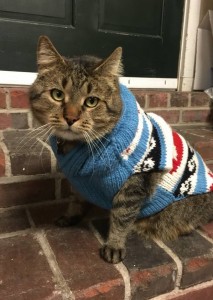By: Robin Desmet – January, 2017
Every mile is two in winter”
~ George Herbert
 Winter is hard. It’s hard for people and it’s even harder for cats—especially for the feral cats that spend their entire lives outdoors. If you have a pet cat that goes outside, please be aware that winter is a dangerous time of year for cats to be outside. Cats are subject to cold weather maladies just like humans and can get frostbite and hypothermia (low body temperature) if they spend too much time out in the cold. The simplest and easiest way to protect your pet in the winter is to keep your cat indoors where it is safe and warm.
Winter is hard. It’s hard for people and it’s even harder for cats—especially for the feral cats that spend their entire lives outdoors. If you have a pet cat that goes outside, please be aware that winter is a dangerous time of year for cats to be outside. Cats are subject to cold weather maladies just like humans and can get frostbite and hypothermia (low body temperature) if they spend too much time out in the cold. The simplest and easiest way to protect your pet in the winter is to keep your cat indoors where it is safe and warm.
If you are caring for a feral colony or have community cats in your area, there are a few things you can do to help these cats out during the cold winter months. The first is to provide the cats with some type of shelter. Outdoor cat shelters are surprisingly inexpensive and easy to build. They can be assembled using materials as simple as plastic storage totes, Styrofoam coolers, duct tape, and straw. There are many online resources with tips and information on outdoor shelters and you can even watch a short video on how to assemble a cat shelter at: ww.alleycat.org/resources/how-to-build-an-outdoor-shelter.
One important point is to always use straw, not hay, to line and insulate outdoor cat shelters. Hay will absorb water and become moldy. Blankets and towels, which seem like an obvious choice for bedding, will also absorb moisture and will stiffen up and not provide enough warmth. The cat shelters do not need to be very large and ideally should be raised a few inches off the ground. Be sure to keep the entry way clear of snow so that the cats can enter and exit.
Besides shelter, providing cats with food and water is essential. Cats need extra food in the winter, and feeding both wet and dry food is best whenever possible. A suitable water dish is one that is deep, thick walled, and preferably made of plastic. Water tends to freeze faster in wide, shallow dishes. Avoid using metal dishes in the winter. Heated electric dishes can be purchased at pet stores and work great to prevent frozen water if an outlet is available.
In addition to the cold, there are also chemical dangers for cats in the wintertime. Antifreeze is highly toxic to cats and can cause kidney failure and death even in very small quantities. Antifreeze should be stored responsibly and spills should be cleaned up immediately to avoid accidental ingestion. “Ice Melt” is also toxic to cats (and dogs) and can cause gastrointestinal upset, skin irritation, and death. Many cats accidently ingest this material when they are cleaning their paws after going outside. If you suspect that your pet has been exposed to any of these toxic chemicals, seek veterinary care immediately.
In dense, urban areas where there are a lot of free roaming cats it is common for cats to take shelter in the engines and wheel wells of parked cars. A couple of raps on the hood of the car can help disperse any sleeping cats before driving off.
Winter can be a harsh time of year for your pets and for the community cats that live outside. Please help the community cats by supplying them with food, shelter, and water. Keep your own pet cats indoors so that they will stay safe. Buy yourself a new sweater and while you’re at it—get one for the cat. Turn up the heat and wait for spring together.
You can email Robin at robinjd@comcast.net
